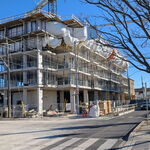whydidimakethis
Active Member
One of the theories behind the numbering of the 413 is that each bypass is 401+6 (407=401+6, 413=407+6). Perhaps 419 for the Toronto Bypass Bypass Bypass Bypass?
Article in The Star suggests the province is looking at 8-laning the Bypass, possibly from the get-go, or in any event by 2041.
The gist of the article is that the province has been peddling this project as a less intrusive 4-lane highway (2 lanes per direction); and that they have been misleading the public.
There is also a suggestion this may reopen the issue of a Federal EA, due to misrepresentation of the project.
Not sure I'm buying on the latter.
Its well known that I oppose this project, in part, because I, as many others, knew full well it would ultimately be bigger.
Is there some chance that casual observers may feel mislead? Perhaps. I oppose it regardless. But I'm not sure this is material misrepresentation; then again, governments of all stripes will soft peddle things they think might generate pushback.
https://www.thestar.com/news/invest...bigger-for-the-controversial-new-highway.html (currently behind paywall)
From the above:
View attachment 445455
View attachment 445456
***
View attachment 445457
****
This bit may be of greater consequence:
View attachment 445458
Cost Inflation of 150% - 400% is rather substantial. Cost is also supposed to be a factor in Evaluating alternatives in an EA.
MTO built the 407 East for $4 billion for about 65km of new urban highway, including 5 new freeway-freeway interchanges. The Bradford Bypass costing $800 million for 16km of 4-lane freeway and two freeway-freeway interchanges actually sounds about right comparatively, as it has no 6-lane portion and does not require an expensive realignment of the 401.Yeah, there's a 0% chance this thing would end up costing $800 million irrespective of whether this is a 4-Lane or 8-Lane highway.
But surprise surprise, the Provincial Conservatives misleading the public as they do on a daily basis. By the time they're done, they will make all the previous Liberal governments scandals look like chump change.
8-lanes is the ultimate design capacity of the highway, i.e. what it can eventually be widened out to.
The 407 East was built for 6 lanes, but has an ultimate 10-lane capacity, for example. The original 407 was similarly initially built as 6-lanes and slowly widened out to 10 lanes over 3 decades across most of it's length.
The Bypass is intended to be built as a 4-lane highway, with an ultimate design width of 8 lanes. This will allow MTO to add lanes as required at a later date for minimal additional cost, as all overpasses will have been designed to accomodate the additional lanes. It's future-proofing, basically.
It would make no sense to build the Bypass as an 8-lane facility off the bat as it would connect to the 404 which is only 4 lanes adjacent to it.
MTO's standard is to design highways to be able to widened to 10 lanes eventually, 8-lanes makes it a smaller facility than normal actually. Likely due to it's short length, MTO figures there will likely never be demand for a 10-lane facility.
Further, this isn't new information. MTO intends to build this as a 4-lane facility and it has always been designed to eventually accommodate 8 lanes, even back to the original EA in the late 1990's.
I'm not sure why this is being sold as misrepresentation. As mentioned, the ultimate configuration has been planned to be 3 general purpose lanes + 1 HOV lane per direction since the original study in the 90s. Plus presenting it openly in the PIC doesn't exactly fit the "misleading the public" narrative.
The eight lane cross section isn't any more intrusive than the four lane, considering lane expansions would be done within the median. The actual corridor right-of-way won't change.
It's also worth noting that the goal with projects like these isn't to "fix" traffic but rather to accommodate growth and provide a more efficient redistribution of traffic from local roads to highways. The no build scenario shows significant overcapacity conditions throughout the local road network, which isn't preferable in any way. If we can accommodate another 20 years of population growth and the movement of goods and services without any deterioration to service levels (i.e., traffic conditions stay the same), that's a win. With careful planning, additional road infrastructure actually leads to less vehicle-kilometres travelled across the network even accounting for potential mode shift and induced demand.
For my type of work, the GO train is never useful as I need to carry tools/ladders so I require a vehicle, and thus ultimately require highways to move around faster. But I 100% agree with what you said here, INVESTING IN NEW RAILWAY CORRIDORS, but sadly no political party pitches the idea.The money would be better spent on a new ROW for the Barrie GO line that shaved 25km off the route with a straighter alignment, making for a more competitive travel time; consideration could be given to an E-W ROW for rail that linked the Bala and Newmarket subs south of Lake Simcoe, with a much lower damage profile.




